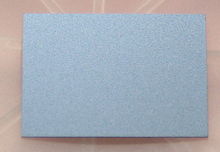Indium phosphide (InP) is a binary semiconductor composed of indium and phosphorus. It has a face-centered cubic ("zincblende") crystal structure, identical to that of GaAs and most of the III-V semiconductors.

| |

| |
| Names | |
|---|---|
| Other names
Indium(III) phosphide | |
| Identifiers | |
3D model (JSmol) |
|
| ChemSpider |
|
| ECHA InfoCard | 100.040.856 |
PubChem CID |
|
| UNII | |
CompTox Dashboard (EPA) |
|
| |
| |
| Properties | |
| InP | |
| Molar mass | 145.792 g/mol |
| Appearance | black cubic crystals[1] |
| Density | 4.81 g/cm3, solid[1] |
| Melting point | 1,062 °C (1,944 °F; 1,335 K)[1] |
| Solubility | slightly soluble in acids |
| Band gap | 1.344 eV (300 K; direct) |
| Electron mobility | 5400 cm2/(V·s) (300 K) |
| Thermal conductivity | 0.68 W/(cm·K) (300 K) |
Refractive index (nD) |
3.1 (infrared); 3.55 (632.8 nm)[2] |
| Structure | |
| Zinc blende | |
a = 5.8687 Å [3] | |
| Tetrahedral | |
| Thermochemistry[4] | |
Heat capacity (C) |
45.4 J/(mol·K) |
Std molar |
59.8 J/(mol·K) |
Std enthalpy of |
-88.7 kJ/mol |
Gibbs free energy (ΔfG⦵) |
-77.0 kJ/mol |
| Hazards | |
| Occupational safety and health (OHS/OSH): | |
Main hazards |
Toxic, hydrolysis to phosphine |
| Safety data sheet (SDS) | External MSDS |
| Related compounds | |
Other anions |
Indium nitride Indium arsenide Indium antimonide |
Other cations |
Aluminium phosphide Gallium phosphide |
Related compounds |
Indium gallium phosphide Aluminium gallium indium phosphide Gallium indium arsenide antimonide phosphide |
Except where otherwise noted, data are given for materials in their standard state (at 25 °C [77 °F], 100 kPa). | |
Indium phosphide can be prepared from the reaction of white phosphorus and indium iodide at 400 °C.,[5] also by direct combination of the purified elements at high temperature and pressure, or by thermal decomposition of a mixture of a trialkyl indium compound and phosphine.[6]
The application fields of InP splits up into three main areas. It is used as the basis for optoelectronic components,[7] high-speed electronics,[8] and photovoltaics[9]
InP is used as a substrate for epitaxial optoelectronic devices based other semiconductors, such as indium gallium arsenide. The devices include pseudomorphic heterojunction bipolar transistors that could operate at 604 GHz.[10]
InP itself has a direct bandgap, making it useful for optoelectronics devices like laser diodes and photonic integrated circuits for the optical telecommunications industry, to enable wavelength-division multiplexing applications.[11] It is used in high-power and high-frequency electronics because of its superior electron velocity with respect to the more common semiconductors silicon and gallium arsenide.
InP is used in lasers, sensitive photodetectors and modulators in the wavelength window typically used for telecommunications, i.e., 1550 nm wavelengths, as it is a direct bandgap III-V compound semiconductor material. The wavelength between about 1510 nm and 1600 nm has the lowest attenuation available on optical fibre (about 0.2 dB/km).[12] Further, O-band and C-band wavelengths supported by InP facilitate single-mode operation, reducing effects of intermodal dispersion.
InP can be used in photonic integrated circuits that can generate, amplify, control and detect laser light.[13]
Optical sensing applications of InP include